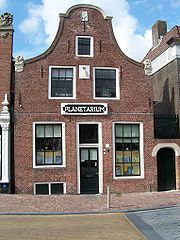
Eise Eisinga
Encyclopedia

Orrery
An orrery is a mechanical device that illustrates the relative positions and motions of the planets and moons in the Solar System in a heliocentric model. Though the Greeks had working planetaria, the first orrery that was a planetarium of the modern era was produced in 1704, and one was presented...
in his house in Franeker, Netherlands
Netherlands
The Netherlands is a constituent country of the Kingdom of the Netherlands, located mainly in North-West Europe and with several islands in the Caribbean. Mainland Netherlands borders the North Sea to the north and west, Belgium to the south, and Germany to the east, and shares maritime borders...
. The orrery still exists and is the oldest functioning planetarium
Planetarium
A planetarium is a theatre built primarily for presenting educational and entertaining shows about astronomy and the night sky, or for training in celestial navigation...
in the world.
Biography
Eisinga was the son of a wool carderCarding
Carding is a mechanical process that breaks up locks and unorganised clumps of fibre and then aligns the individual fibres so that they are more or less parallel with each other. The word is derived from the Latin carduus meaning teasel, as dried vegetable teasels were first used to comb the raw wool...
, Jelte Eises from Oosterlittens and mother Hitje Steffens from Winsum
Winsum
Winsum is a municipality and a town in the northeastern Netherlands.The town of Winsum was officially established in 1057 as the fusion of three historic villages: Obergum , Winsum and Bellingeweer...
. Although he was moderately gifted, he wasn’t allowed to go to school. When he was only 17 years old he published a book about the principles of astronomy. Eisinga became a wool carder in Franeker, Netherlands. Through self-education he mastered mathematics
Mathematics
Mathematics is the study of quantity, space, structure, and change. Mathematicians seek out patterns and formulate new conjectures. Mathematicians resolve the truth or falsity of conjectures by mathematical proofs, which are arguments sufficient to convince other mathematicians of their validity...
and astronomy, which he also studied at the Franeker Academy
University of Franeker
The University of Franeker was a university in Franeker, Friesland, presently part of the Netherlands. It was the second oldest university of the Netherlands, founded shortly after Leiden University....
. At the age of 24 he married Pietje Jacobs (? – 24 July 1788) and they had three children, one girl and two boys.
- Trijntje (April 1773 – 26 April 1773)
- Jelte (29 May 1774 – 31 March 1809)
- Jacobus (17 March 1784 – 24 March 1858)
Due to a political crisis in 1787, he had to leave Friesland
Friesland
Friesland is a province in the north of the Netherlands and part of the ancient region of Frisia.Until the end of 1996, the province bore Friesland as its official name. In 1997 this Dutch name lost its official status to the Frisian Fryslân...
and went to Germany. Later he moved to Visvliet where he worked as a wool comber. He was banned from Friesland for five years and therefore stayed in Visvliet just across the border in Groningen. Meanwhile his wife died, and on 27 May 1792 he married Trijntje Eelkes Sikkema (21 February 1764) in Visvliet. They had one son and two daughters.
- Eelke (14 October 1793 – 28 May 1795)
- Hittje (16 February 1796 – 8 May 1843)
- Minke (4 June 1798 – 17 July 1870)
In 1795 he returned to Franeker.
Eisinga became a professor at the Franeker Academy
University of Franeker
The University of Franeker was a university in Franeker, Friesland, presently part of the Netherlands. It was the second oldest university of the Netherlands, founded shortly after Leiden University....
, until 1811 when Napoleon ordered it to be closed.
Eisinga died on 27 August 1828, at the age 84.
Orrery


Conjunction (astronomy)
Conjunction is a term used in positional astronomy and astrology. It means that, as seen from some place , two celestial bodies appear near one another in the sky...
of the moon and the planets Mercury, Venus, Mars, Jupiter was forecast to appear. Reverend Eelco Alta, from Boazum
Boazum
Boazum is a Frisian village in the rural municipality of Littenseradiel, Netherlands with an approximate population of 400. It is one of the first described communities in Friesland...
, Netherlands, published a book in which he predicted that the planets and the moon would collide, with the result that the earth would be pushed out of its orbit and burned by the sun. Due to this prediction there was a lot of panic in Friesland. To prove that there was no reason for panic, Eisinga decided to build an orrery in his living room. He expected to finish it within six months and eventually finished it in 1781, seven years after he started. During the same year Uranus was discovered, but there was no room for this planet on the ceiling of his living room, where the orrery was located.
On 30 June 1818 King William I of the Netherlands
William I of the Netherlands
William I Frederick, born Willem Frederik Prins van Oranje-Nassau , was a Prince of Orange and the first King of the Netherlands and Grand Duke of Luxembourg....
and Prince Frederik visited the orrery. King William I bought the orrery for the Dutch state. In 1859 the orrery was donated by the Dutch state to the city of Franeker.

